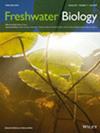欧洲和地中海盆地淡水等足类复群Proasellus coxalis (Dollfus, 1892)的组成、分布和历史的新认识
IF 2.7
2区 生物学
Q2 ECOLOGY
引用次数: 0
摘要
有问题的分类群,通常被称为物种复合体,在淡水生物中很常见。了解它们的物种组成、分布和历史是将这些分类群纳入许多生态学学科的关键。本文研究了地中海盆地和中欧淡水中具有重要功能的无尾类等足动物群(panrustaceae)——Proasellus coxalis的分类和生物地理特征。通过系统发育和系统地理分析,研究了该物种的多样性、系统发育位置和历史生物地理特征。首先,我们使用基于线粒体细胞色素氧化酶亚基I (COI)基因的分子物种划分方法来鉴定代表该复合体中假定物种的分子操作分类单位(MOTUs)。其次,我们使用另外三个基因——16S线粒体rDNA、FASTKD4核基因和28S核rDNA基因——来生成一个四基因的Asellidae系统发育,以测试PCC的单系性和系统发育位置。第三,应用统计祖先重建方法对四基因定年系统发育进行分析,推断其生物地理历史。第四,利用基于COI和16S基因的贝叶斯系统地理扩散模型重构了该物种复合体中唯一广泛分布的MOTU的范围动态。我们在PCC中发现了≥25个motu。东地中海盆地,包括庞地中海半岛和意大利半岛,包含许多分布狭窄的motu。相比之下,中欧,意大利北部,Dinarides,伊比利亚半岛和西北非洲被单一的MOTU殖民,我们称之为P. banyulensis。四基因的系统发育将所有的PCC MOTUs聚集在一个有良好支持的单系群中,我们称之为P. coxalis分支。祖先重建方法表明,该分支起源于中新世早期的希腊南部,当时是巴尔干-安纳托利亚大陆的一部分。从那里开始,它主要在中新世分散和分化,穿过地中海东部盆地,包括意大利半岛。贝叶斯系统地理扩散模型显示,中欧和西地中海盆地是最近从P. banyulensis意大利种群移居的。在更新世期间,该物种的多次殖民浪潮紧随其后,从意大利中部开始,最北(德国、瑞典)和最南(西班牙南部、摩洛哥和阿尔及利亚)地区最后被殖民。我们解决了一个多世纪以来PCC研究中存在的主要分类、系统发育和生物地理上的不确定性。我们对这个复合体的最新理解是,一个物种丰富的进化支在地中海东部盆地长期多样化,但其中有一个单一的物种- p。巴尤伦斯——最近从意大利难民那里殖民了中欧和西地中海盆地。在中欧,这一物种与另外两个广泛分布的物种——来自潘诺尼亚难民的阿塞勒斯(asellus aquaticus)和最有可能来自伊比利亚难民的子午线阿塞勒斯(P. meridianus)——一起形成了混合的阿塞勒斯群落。本文章由计算机程序翻译,如有差异,请以英文原文为准。
New Insights Into the Composition, Distribution and History of the Freshwater Isopod Species Complex Proasellus coxalis (Dollfus, 1892) in Europe and the Mediterranean Basin
- Problematic taxa, often referred to as species complexes, are common among freshwater organisms. Understanding their species composition, distribution and history is key to integrating these taxa into many ecological disciplines. We investigated the taxonomy and biogeography of the Proasellus coxalis species complex (PCC), a diversified and functionally important group of asellid isopods (Pancrustacea) in freshwaters of the Mediterranean Basin and central Europe.
- We used phylogenetic and phylogeographic analyses from specimens collected at 143 localities across the range of the PCC to document its diversity, phylogenetic position and historical biogeography. First, we used molecular species delimitation methods based on the mitochondrial cytochrome oxidase subunit I (COI) gene to identify molecular operational taxonomic units (MOTUs) representing putative species within that complex. Second, we used three additional genes—the 16S mitochondrial rDNA, FASTKD4 nuclear and 28S nuclear rDNA genes—to generate a four-gene dated phylogeny of Asellidae to test the monophyly and phylogenetic position of the PCC. Third, we applied statistical ancestral reconstruction methods to the four-gene dated phylogeny of the PCC to infer its biogeographic history. Fourth, we used Bayesian phylogeographic diffusion models based on the COI and 16S genes to reconstruct the range dynamics of the only widely distributed MOTU in this species complex.
- We identified ≥ 25 MOTUs within the PCC. The eastern Mediterranean Basin, including the Pontic-Mediterranean and Italian peninsulas, contained numerous narrowly distributed MOTUs. In contrast, central Europe, northern Italy, the Dinarides, the Iberian peninsula and northwestern Africa were colonised by a single MOTU, which we term P. banyulensis. The four-gene phylogeny of the Asellidae clustered all PCC MOTUs into a well-supported monophyletic group, which we term the P. coxalis clade. Ancestral reconstruction methods indicated that the clade originated during the early Miocene in the southern Hellenides, at that time part of the Balkanian-Anatolian landmass. From there, it dispersed and diverged mainly during the Miocene, through the eastern Mediterranean Basin, including the Italian peninsula. Bayesian phylogeographic diffusion models revealed that central Europe and the western Mediterranean Basin were recently colonised from Italian populations of P. banyulensis. During the Pleistocene, multiple waves of colonisation of that species followed each other from central Italy, the most northerly (Germany, Sweden) and southerly (southern Spain, Morocco and Algeria) regions being colonised last.
- We resolved major taxonomic, phylogenetic and biogeographic uncertainties that have marked more than a century of research on the PCC. Our updated understanding of this complex is that of a species-rich clade that has long diversified in the eastern Mediterranean Basin, but of which a single species—P. banyulensis—has recently colonised central Europe and the western Mediterranean Basin from Italian refugia. In central Europe, this species adds to two other widespread species—Asellus aquaticus from Pannonian refugia and P. meridianus, most probably from Iberian refugia—to produce mixed asellid communities.
求助全文
通过发布文献求助,成功后即可免费获取论文全文。
去求助
来源期刊

Freshwater Biology
生物-海洋与淡水生物学
CiteScore
5.90
自引率
3.70%
发文量
162
审稿时长
2 months
期刊介绍:
Freshwater Biology publishes papers on all aspects of the ecology of inland waters, including rivers and lakes, ground waters, flood plains and other freshwater wetlands. We include studies of micro-organisms, algae, macrophytes, invertebrates, fish and other vertebrates, as well as those concerning whole systems and related physical and chemical aspects of the environment, provided that they have clear biological relevance.
Studies may focus at any level in the ecological hierarchy from physiological ecology and animal behaviour, through population dynamics and evolutionary genetics, to community interactions, biogeography and ecosystem functioning. They may also be at any scale: from microhabitat to landscape, and continental to global. Preference is given to research, whether meta-analytical, experimental, theoretical or descriptive, highlighting causal (ecological) mechanisms from which clearly stated hypotheses are derived. Manuscripts with an experimental or conceptual flavour are particularly welcome, as are those or which integrate laboratory and field work, and studies from less well researched areas of the world. Priority is given to submissions that are likely to interest a wide range of readers.
We encourage submission of papers well grounded in ecological theory that deal with issues related to the conservation and management of inland waters. Papers interpreting fundamental research in a way that makes clear its applied, strategic or socio-economic relevance are also welcome.
Review articles (FRESHWATER BIOLOGY REVIEWS) and discussion papers (OPINION) are also invited: these enable authors to publish high-quality material outside the constraints of standard research papers.
 求助内容:
求助内容: 应助结果提醒方式:
应助结果提醒方式:


